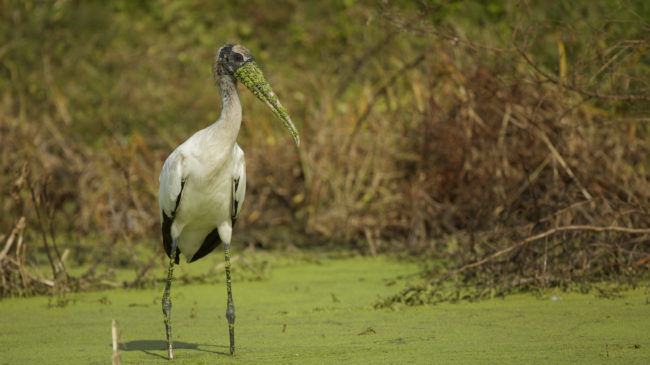Florida is one of the fastest growing states in the nation with over 300,000 new residents arriving each year, but the environmental costs of rapid development could jeopardize future growth. Decades of water mismanagement have exacerbated naturally occurring algal blooms that are now plaguing the Sunshine State. Toxic cyanobacteria, or blue-green algae, thrive in freshwater and brackish habitats like the lakes, rivers, and estuaries found throughout Florida. Algal blooms occur when large amounts of nutrients—nitrogen and phosphorus—enter a body of water causing a slimy green layer to form on the water’s surface in a process known as eutrophication.
Improved water management and algal bloom mitigation are necessary to sustaining Florida’s growth. Economic growth, public health, and quality of life in Florida depend on the quality, quantity, timing, and distribution of water resources. Addressing blue-green algal blooms in Florida requires action at the private, municipal, state, and federal levels.
Increased nutrient levels, combined with sunlight and slow-moving water, provide the necessary conditions for algal blooms to form. Non-toxic algae can kill fish by clogging their gills and kill plant-life by blocking sunlight from reaching below the surface. As the algae die, their decomposition consumes large amounts of oxygen in the water which suffocates fish and other marine animals. This oxygen depletion is known as hypoxia and leads to “dead zones” in oceans, lakes, and rivers. Large algal blooms can result in thousands of dead fish whose decomposition further pollute water systems and contribute to further algal growth. In addition to the effects of non-toxic algal blooms, toxic blue-green algae can accumulate through the food chain as smaller organisms consume algae and are then consumed by larger organisms. Severe blooms can kill wildlife and have serious health consequences for humans. According to state officials, contact with or accidental ingestion of the algae can cause irritation of the gastrointestinal tract, liver, nervous system, and skin. Research also suggests that long-term exposure to blue-green algae through the consumption of aquatic organisms may be linked to the development of neurodegenerative disorders like ALS and Alzheimer’s.
Algal blooms and their associated health risks could hurt tourism along with large segments of Florida’s economy. Tourists list Florida’s beaches as their primary reason for visiting—more often than theme parks, retail, dining, and nightlife. When tourists visit Florida, they stay in hotels, eat at restaurants, and shop—contributing to the state’s overall economic activity. If algal blooms deter tourists, it could have rippling effects throughout the economy. Florida is also known as the sportfishing capital of the world. In the year 2011 alone, over 1.9 million residents and 1.2 million visitors fished in Florida waters, but algal blooms are threatening Florida’s sportfishing industry and the economies of many coastal communities. Marinas, boat charters, and bait shops have struggled as deteriorating water quality continues to reduce fish populations and drive away visiting anglers.
Blue-green algal blooms occur in water bodies all around the state, including the St. Johns and Loxahatchee rivers, but Lake Okeechobee and the wider Everglades region are by far the largest and most complex components of Florida’s water quality issues. Blooms are largely caused by nutrient runoff into the lake from Orlando and Kissimmee that then flows to the coasts through the Caloosahatchee and St. Lucie Rivers. Severe algal blooms have become more frequent over recent years causing state of emergency declarations in 2016 and 2018. These episodes were largely triggered by major storm events and higher-than-average rainfall in those years. In July 2018, the National Oceanic and Atmospheric Administration reported that up to 90 percent of Lake Okeechobee contained the toxic blue-green algae. Later that summer, areas along the Caloosahatchee and St. Lucie rivers also experienced algal blooms, which led to environmental and economic damages in the surrounding communities.
Florida lawmakers passed the sweeping Clean Waterways Act in 2020 which addressed many of the underlying causes of algal blooms. However, there is broad consensus that additional action is necessary. Disagreement over who is responsible and the best approach to mitigation will likely stall further management efforts. Environmental groups point to agricultural producers and the disruption of natural water flows through the Everglades. Others cite urban and suburban runoff including fertilizers and untreated wastewater. The truth is most likely a combination of all these factors. This report aims to identify the causes of water degradation, mechanisms for mitigation, and how to fund the necessary interventions. The findings and recommendations of the report closely align with the first round of recommendations from Florida’s recently appointed Blue-Green Algae Task Force.
Full Policy Brief: Solving Florida’s Blue-Green Algae Bloom Crisis

